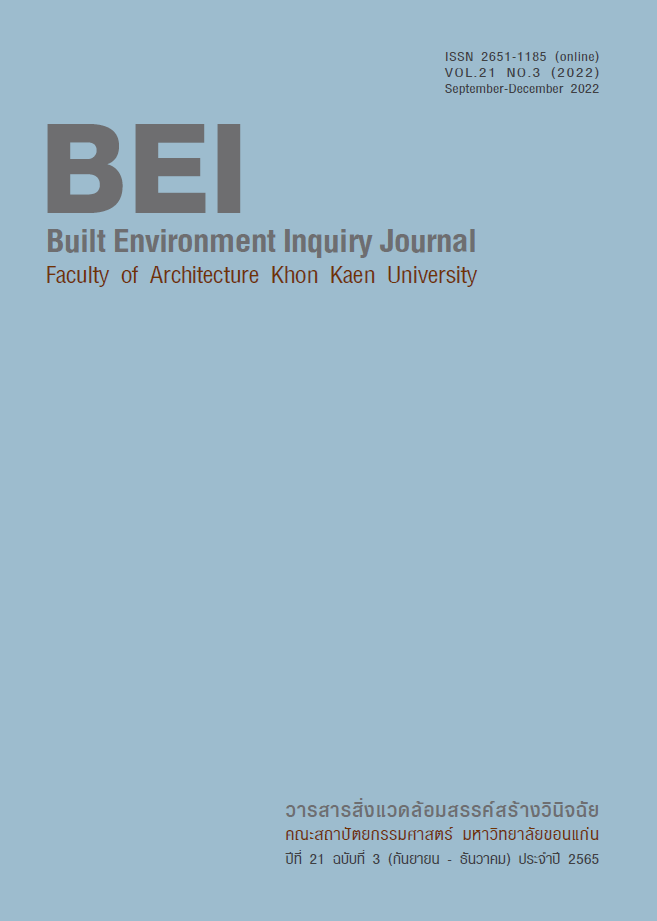Studying Activities, Behaviors, and Impression of Users in the Green Spaces in Khon Kaen University Campus
คำสำคัญ:
Green space, Campus, Activities and Behaviors, Users, Impressionsบทคัดย่อ
งานวิจัยชิ้นนี้มุ่งเน้นการศึกษาเกี่ยวกับผลจากองค์ประกอบกายภาพที่มีต่อกิจกรรม พฤติกรรม และการรับรู้ของผู้ใช้งานพื้นที่สาธารณะสีเขียวภายในรั้วมหาวิทยาลัยขอนแก่นสองแห่ง คือ สวนสาธารณะบึงศรีฐาน และสระพลาสติก ทั้งนี้ผู้วิจัยได้ใช้ Caption Evaluation Method (CEM) และ แบบสอบถามออนไลน์ เป็นเครื่องมือในการรวบรวมข้อมูลวิจัย โดย CEM จะถูกนำมาใช้เพื่อบันทึกพฤติกรรม ลักษณะกิจกรรม รวมถึงลักษณะกายภาพของพื้นที่สีเขียวในช่วงเวลาที่ต่างกัน แล้วนำมาสรุปเป็นแผนที่แสดงพฤติกรรมการทำกิจกรรมของแต่ละช่วงเวลาเหล่านั้น ในขณะที่แบบสอบถามออนไลน์จะทำการสอบถามที่เกี่ยวข้องกับการทำกิจกรรม การรับรู้ และข้อคิดเห็นต่างๆของอาสาสมัครผู้ตอบแบบสอบถามที่มีประสบการณ์ในการเข้ามาใช้พื้นที่สีเขียวทั้งสอง ผลจากงานวิจัยแสดงให้เห็นว่ากิจกรรมทั้งเก้า คือ วิ่งออกกำลังกาย นั่งเล่น พบปะเพื่อนฝูง ให้อาหารปลา เดินเล่นกับสัตว์เลี้ยง พูดคุย เข้าร่วมงานเทศกาล เล่นเกมกีฬาชนิดต่างๆ และสูบบุหรี่ มีความสัมพันธ์กับการรับรู้ นอกจากนี้ผู้ตอบแบบสอบถามส่วนใหญ่ยังมีข้อเสนอให้ทำการปรับปรุงและเพิ่มเติมลู่วิ่ง ห้องน้ำสาธารณะ และจุดทิ้งขยะ อีกด้วย
เอกสารอ้างอิง
Abercrombie, N., Gatrell, T. and Thomas, C. (1998). Universities and health in the twenty-first century. [n.p.]: Health promoting universities.
Abu-Ghazzeh, T.M. (1999). Communicating behavioral research to campus design: Factors affecting the perception and use of outdoor spaces at the University of Jordan. Environment and behavior, 31(6), 764-804.
Andy Honga, A., Sallis, J.F., King, A.C., Conway, T.L., Saelens, B., Cain, K.L., Fox, E.H., and Frank, L.D. (2018). Linking green space to neighborhood social capital in older adults: The role of perceived safety. Social Science & Medicine, 207, 38-45.
Barker, R.G. (1968). Ecological Psychology: Concepts and Methods for Studying the Environment of Human Behavior. California: Standford University. Figure 5: Crowd density in Plastic Lake weekday and weekend
Belmeziti, A., Cherqui, F., & Kaufmann, B. (2018). Improving the multi-functionality of urban green spaces: Relations between components of green spaces and urban services. Sustainable cities and society, 43, 1-10.
Do, D.T., Cheng, Y., Shojai, A. and Chen, Y. (2019). Public park behavior in Da Nang: An investigation into how open space is used. Frontiers of Architectural Research, 8(4), 454-470.
Felsten, G. (2009). Where to take a study break on the college campus: An attention restoration theory perspective. Journal of environmental psychology, 29(1), 160-167.
Gumprecht, B. (2008). The campus as a public space in the American college town. Journal of Historical Geography, 33(1), 72-103.
Hall, E.T. (1963). A system for the notation of proxemic behavior. American Anthropologist. 65, 1003-26.
Kazmierczak, A.E., and James, P. (2007). The role of urban green spaces in improving social inclusion. Retrieved May 22, 2022, from http://www.usir. salford.ac.uk/11339
Khon Kaen University. (2020). Green University. Retrieved May 22, 2022, from https://www.green.kku.ac.th/setting-and-infrastructure-si/
Koga, T., Taka, A., Munakata, J., Kojima, T., Hirate, K., and Yasuoka, M. (1999) Participatory research of townscape, using 'caption evaluation method': studies of the cognition and the evaluation of townscape, Part 1. Journal of Architectural Planning and Environmental Engineering, AIJ, 517, 79-84.
Li, X., Ni, G., and Dewancker, B. (2019). Improving the attractiveness and accessibility of campus green space for developing a sustainable university environment.
Neto, O,V, Jeong, S., Munakata, J., Yoshida, Y., Ogawa, T., and Yamamura, S. (2018). Physical Element Effects in Public Space Attendance. Journal of Asian Architecture and Building Engineering, 15(3), 479-485.
Patel, M. (2019). Campus Design: Assessing Outdoor Spaces at California Polytechnic State University, San Luis Obispo to Improve Student Experience. Proceeding of the National Academy of Sciences of the United States of America, 112(26), 7937-7942.
Whyte, H. W. (2000). How to turn a place around. Projects for Public Space Inc, 52.
ดาวน์โหลด
เผยแพร่แล้ว
รูปแบบการอ้างอิง
ฉบับ
ประเภทบทความ
สัญญาอนุญาต
ลิขสิทธิ์ (c) 2022 สิ่งแวดล้อมสรรค์สร้างวินิจฉัย

อนุญาตภายใต้เงื่อนไข Creative Commons Attribution-NonCommercial-NoDerivatives 4.0 International License.
ทัศนะและข้อคิดเห็นของบทความที่ปรากฏในวารสารฉบับนี้เป็นของผู้เขียนแต่ละท่าน ไม่ถือว่าเป็นทัศนะและความรับผิดชอบของกองบรรณาธิการ




